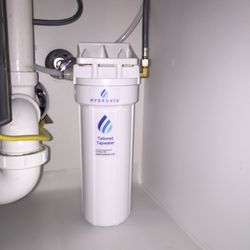Bioaccumulation & Biomagnification Of Toxic Chemicals:
What You Need To Know
Wendy Spicer, M.S. | Scientific Contributor
Editor’s Note: We’ve been writing more articles about organic chemicals like endocrine disruptors, methylated mercury, so we’ve been getting a lot of questions about how people become exposed to these chemicals. Even though these questions deal more with food than drinking water, we though that it’d be worthwhile to spend some time on an article explaining how this happens.
What is Bioaccumulation?
Bioaccumulation refers to the process of toxic chemicals building up inside of an organism’s body. This happens when a chemical is consumed or absorbed, and the body cannot catabolize or excrete it quickly enough. Mercury is a well-known chemical that will bioaccumulate in humans. We commonly hear about mercury exposure resulting from eating fish such as tuna (or other large predatory fish). However, mercury as well as many other harmful chemicals can also be found in drinking water supplies across the United States.
Chemicals that tend to bioaccumulate are stored in cells and not exposed to direct physical or biochemical degradation. These chemicals can collect and hide-out, particularly within adipose tissue (fat cells). Fatty mammary tissue often contains the highest concentrations of toxic chemicals. These chemicals in our mammary tissue are then passed along to infants when nursing.
What is Biomagnification?
Image from http://biology.tutorvista.com/environmental-pollution/effects-of-water-pollution.html
Biomagnification refers to the process of toxic chemicals increasing in concentration as they move throughout a food chain. Bioaccumulation and biomagnification often work hand-in-hand; one animal accumulates chemicals in the body (bioaccumulation) and then a larger predator consumes that smaller animal such that the chemical is passed along to the predator. The chemical “magnifies” as the resulting concentrations increase in the predator because it likely consumes large quantities of that particular prey throughout its lifetime (biomagnification). As top-level predators in our own food chain, humans tend to collect high concentrations of toxic chemicals in our bodies.
What are Persistent Bioaccumulative Toxics (PBTs)?
PBTs are a particular group of chemicals that threaten the health of humans and the environment. Examples include methylmercury, polychlorinated biphenyls (PCBs), dichloro-diphenyl-trichloroethane (DDT), and dioxins. PBTs are considered extremely dangerous to both humans and wildlife because they remain in the environment for a very long time without breaking down, then bioaccumulate and biomagnify in ecosystems (including ours).
PBTs can also travel long distances and move between air, water, and land. DDT, a notorious environmental pollutant, was developed as a synthetic insecticide in the 1940s. Sprayed over crops, DDT would then wash into water supplies and contaminate lakes, ponds, streams, rivers, and oceans. Small organisms such as plankton and algae absorb DDT through the water. Smaller fish then consume the contaminated algae and plankton. Larger predatory fish then consume the smaller fish. Eventually, large predatory birds or humans eat the contaminated fish. Despite being banned in the United States over 40 years ago, DDT is still found in soil and water supplies today. In addition, humans contain the highest concentrations of DDT when compared to other organisms.
How Does This Impact Human Health?
Exposure to PBTs has been linked to a wide range of toxic effects in humans and wildlife. Some of those adverse effects include but are not limited to disruption of the nervous and endocrine systems, reproductive and developmental problems, immune system suppression, and cancer.
How Can I Minimize Exposure To PBTs?
- Avoid eating species of fish that are long-lived and high on the food chain such as tuna, marlin, shark, swordfish, king mackerel, and tilefish.
- Use a high quality water filters that removes PBTs (e.g. DDT, Dioxins, BPA, Phthalates from contaminated drinking water before the chemicals get a chance to accumulate in you
NOAGENATION.COM
